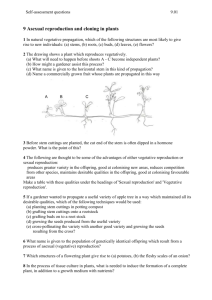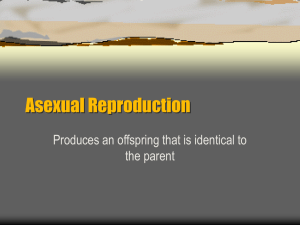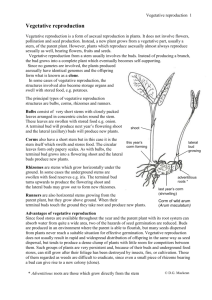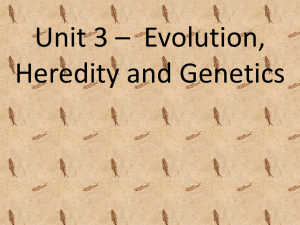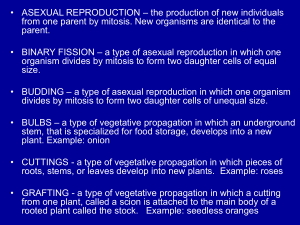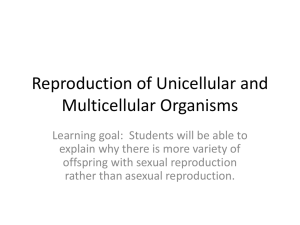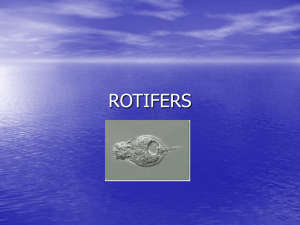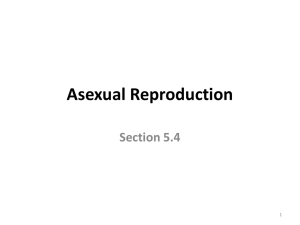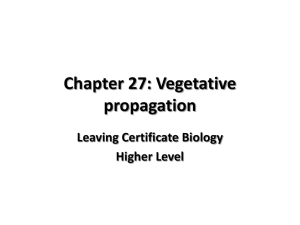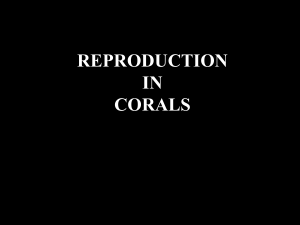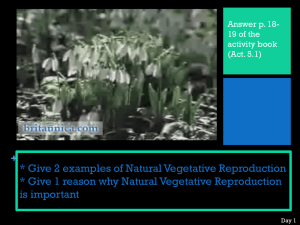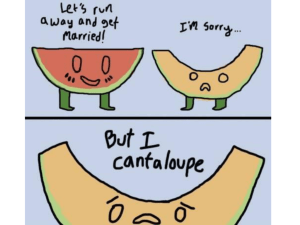Reproduction Part 1 Asexual vs. Sexual Reproduction
advertisement
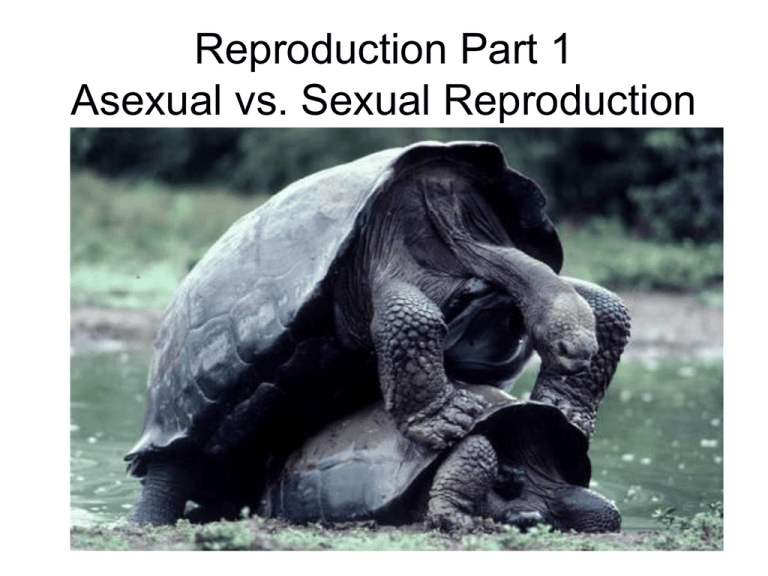
Reproduction Part 1 Asexual vs. Sexual Reproduction Objectives • Compare and contrast sexual reproduction vs. asexual reproduction • Understand and explain the 5 types of asexual reproduction Asexual vs. Sexual Reproduction • What are the main differences between sexual and asexual reproduction? • List any advantages and disadvantages of each. Types of Asexual Reproduction • • • • • 1. Binary Fission 2. Budding 3. Regeneration 4. Sporulation (Spore Formation) 5. Vegetative Propagation Binary Fission • Binary Fission: • Occurs in single celled organisms such as bacteria, protists (amoeba, euglena, etc.), algae. • The cell increases in size until it divides into two new cells • No parent is left. Binary Fission Budding • Budding: • Occurs in single celled and some simple multicellular organisms such as yeast, hydra, and sponges. • A small bud or outgrowth forms on the organism • The organism divides into two unequal parts – the bud is smaller than the parent organism it sprouted from. • Budding in single celled yeast. • Budding in hydra Regeneration • Regeneration: • Occurs in simple multicellular organisms (hydra, starfish, sponges, earthworms) • If cut into pieces, pieces will grow into new organisms. • Simpler organisms (sponges, cnidarians, echinoderms) are rich in embryonic stem cells which can differentiate to regenerate tissue. • More complex organisms such as humans lack these stem cells as adults and cannot regenerate. An entire starfish can regenerate from a lost limb (ray)!!! Sporulation: Spore formation • Occurs in fungus, algae and mold • Process in which any cell of an organism produces one or more reproductive cells inside its cell walls • Tiny spores form inside the parent cell and are released • Spores are released and carried to a favorable environment (by swimming, wind, etc.) where they can grow into an adult organism. Spore formation in mold Vegetative Reproduction • Vegetative Reproduction: • Some plants can grow from roots, stems, and leaves. • Bulbs and tubers are underground stem structures that can grow to form new plants. • Examples include tulips, potatoes, strawberries, irises. Vegetative Reproduction • Tubers: Enlarged portion of an underground stem that contains stored nutrients (starch). • Potatoes can be cut into pieces with each piece having an “eye” which can grow into a new potato plant. Vegetative Reproduction • Bulbs: Short underground stems surrounded by thick fleshy leaves that contain stored food. • As the plant grows small new bulbs sprout from the old one. • Each bulb can grow into a new plant • Ex. Onions, tulips, garlic. Vegetative Reproduction • Runner (stolon): Stem that grows sideways along the surface of the ground. • Runners have buds that can grow into new plants when they contact soil. • Ex. Strawberry plants, silverweed. Vegetative Reproduction • Rhizome: Stem that grows sideways underground. • Rhizomes are thick and fleshy and contain stored food. • Enlarged portions called nodes grow into buds which can form new plants. • Ex. Irises, ginger. Methods of Artificial Vegetative Reproduction • Cutting: Any vegetative part of a plant (stem, leaf, root) that is used to make a new plant. • Layering: Stem is bent over so part of it is covered with soil. When covered part roots, new plant may be cut from parent plant. • Grafting: Stem or bud is removed from one plant and permanently joined to the stem of another closely related plant. Many fruits and roses are propagated using grafting. Grafting consists of two parts, the stock and the scion SCION STOCK Begonia plants growing from cuttings Grafting in cactus plants
